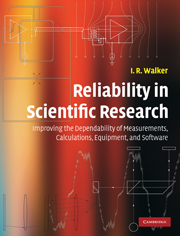 Reliability in Scientific Research
Reliability in Scientific Research Published online by Cambridge University Press: 05 June 2012
Introduction
The most annoying problems that are encountered during the use of electronic systems are often intermittent in nature. Electromagnetic interference, corona and arcing in high-voltage circuits, and some other causes of potentially intermittent faults, are covered in this chapter. Other reliability problems in electronic hardware, such the failure of high-power equipment, are also discussed below.
Difficulties involving electrical contacts, connectors and cables are very common in electronic work, and frequently intermittent. These are dealt with in Chapter 12. Problems with mains power disturbances and overheating of equipment are considered in Sections 3.6 and 3.4.1, respectively. Vibrations can be a cause of noise in electronic systems in the form of microphonics, and these are discussed in Section 3.5.3. A general survey of some of the causes of intermittent failures in experimental work is presented in Section 3.3.
With some exceptions, details of the design, construction, and troubleshooting of electronic circuits and equipment items (e.g. self-contained electronic instruments) are not discussed in this chapter. Such information is provided in references listed in the “Further reading” section on page 403.
Electromagnetic interference
Grounding and ground loops
General points
Importance of grounding arrangements
Proper grounding is generally necessary for the reliability of electronic systems. This includes both the topology of ground networks, and the quality of the electrical contacts made between ground conductors. (The latter is discussed in Section 12.2.4.) Failure to provide an adequate ground arrangement often leads to erratic noise problems and system malfunctions.
To save this book to your Kindle, first ensure [email protected] is added to your Approved Personal Document E-mail List under your Personal Document Settings on the Manage Your Content and Devices page of your Amazon account. Then enter the ‘name’ part of your Kindle email address below. Find out more about saving to your Kindle.
Note you can select to save to either the @free.kindle.com or @kindle.com variations. ‘@free.kindle.com’ emails are free but can only be saved to your device when it is connected to wi-fi. ‘@kindle.com’ emails can be delivered even when you are not connected to wi-fi, but note that service fees apply.
Find out more about the Kindle Personal Document Service.
To save content items to your account, please confirm that you agree to abide by our usage policies. If this is the first time you use this feature, you will be asked to authorise Cambridge Core to connect with your account. Find out more about saving content to Dropbox.
To save content items to your account, please confirm that you agree to abide by our usage policies. If this is the first time you use this feature, you will be asked to authorise Cambridge Core to connect with your account. Find out more about saving content to Google Drive.